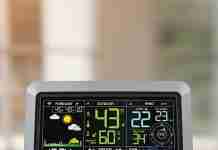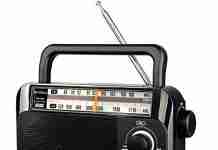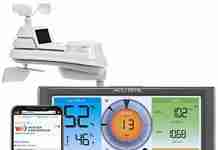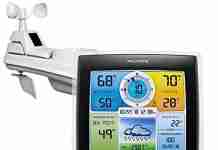We all love having a home weather station to keep track of the weather conditions around us. It not only helps us plan our outdoor activities but also satisfies our curiosity about the ever-changing climate. However, have you ever wondered what factors might affect the accuracy of the wind measurements on your home weather station? In this article, we will explore some of the key factors that can influence wind measurements and how they can impact the reliability of your weather data. So, let’s uncover the secrets behind your home weather station’s wind measurements!
Review contents
Location
Geographic Location
The geographic location of your home weather station plays a crucial role in determining the accuracy of wind measurements. If your station is situated in a wide-open area, away from any tall structures or obstructions, you are more likely to obtain precise and reliable data. However, if your station is surrounded by buildings, trees, or other obstacles, it can significantly affect the wind patterns, leading to distorted measurements.
Obstructions
Obstructions such as buildings, trees, and nearby structures can create turbulence and alter the flow of wind. These obstructions can cause the wind to funnel or create eddies, resulting in inaccurate wind measurements. Therefore, it is important to position your station in a location where it is least impacted by obstructions to obtain the most accurate wind data.
Elevation
The elevation of your home weather station can influence the wind measurements. Higher elevations tend to experience stronger winds due to reduced surface friction. If your station is situated at a higher altitude, the wind speeds recorded may differ from those at lower elevations. Therefore, it is essential to consider the elevation while interpreting the wind data and comparing it with other stations at different altitudes.
Physical Setup
Mounting Height
The height at which you mount your weather station’s anemometer can affect the accuracy of wind measurements. The ideal mounting height varies depending on the surrounding obstructions and the required precision of data collection. As a general rule, the anemometer should be installed at a height that exceeds the nearby obstacles by at least ten times their height. This helps minimize the interference caused by obstructions and provides more precise wind speed and direction readings.
Sensor Placement
Proper sensor placement is crucial to obtain accurate wind measurements. The anemometer sensors should be positioned in an open area, free from any obstructions that could influence the wind flow. Placing the sensors on a rooftop or mast that is higher than nearby structures and objects will help minimize any interference and yield more reliable data.
Sensor Exposure
Exposing the sensors to the elements in an appropriate manner is important for accurate wind measurements. Ensure that the anemometer and wind vane are not shielded by nearby structures, as this can cause airflow disruptions and inaccurate readings. It is also recommended to protect the sensors from direct sunlight or excessive heat, as it can impact their performance. A shield or cover can be used to prevent direct exposure while allowing for proper wind detection.
Instrumentation
Sensor Accuracy
The accuracy of the sensors used in your home weather station determines the precision of wind measurements. It is essential to invest in high-quality sensors that have been calibrated to provide accurate data. Cheaper or poorly calibrated sensors may introduce errors and inconsistencies into your wind measurements, leading to unreliable information. Therefore, always opt for reputable and accurate sensor models to ensure the most reliable data collection.
Sensor Maintenance
Regular maintenance of your weather station sensors is vital to maintain their accuracy. Dust, debris, or even bird droppings can accumulate on the sensors over time, affecting their performance. It is recommended to clean the sensors periodically, following the manufacturer’s guidelines, to ensure accurate readings. Additionally, inspecting the sensors for any signs of damage or wear is important and should be addressed promptly.
Sensor Calibration
Sensor calibration is a critical aspect of ensuring accurate wind measurements. Over time, sensors may drift or deviate from their original calibration, leading to erroneous readings. It is advisable to calibrate the sensors periodically, following the manufacturer’s instructions or consulting a professional technician. Calibration involves adjusting the sensor’s output to match known reference values, ensuring accurate and reliable wind data.
Climate
Local Climate Patterns
Understanding the local climate patterns is essential for interpreting wind measurements correctly. Different regions experience varying wind patterns influenced by factors such as proximity to oceans, mountains, or prevailing weather systems. Being aware of your local climate patterns helps contextualize the wind data obtained from your home weather station and make more accurate comparisons and forecasts.
Microclimate Effects
Microclimate refers to the localized climate conditions that can differ from the broader regional climate. Factors such as nearby bodies of water, vegetation, or varying topography can create microclimate effects. These effects can influence wind speed and direction in the immediate vicinity of your weather station, potentially causing variations in your measurements compared to nearby stations. Understanding the microclimate around your station is important for correctly interpreting and analyzing wind data.
Wind Direction
Wind Vane Alignment
Proper alignment of the wind vane is crucial for accurate wind direction measurements. The wind vane should be installed in a position that allows it to freely respond to wind flow without any obstructions. Avoid placing the wind vane near structures or objects that could disrupt wind patterns. Ensuring the wind vane is properly aligned and balanced will help provide reliable wind direction data.
Sensor Offset
In some cases, the wind direction recorded by your home weather station may be influenced by sensor offset or misalignment. This can occur due to factors such as anemometer mounting errors, sensor installation issues, or magnetic interference. To ensure accurate wind direction readings, carefully check the sensor alignment and positioning, and address any offset issues promptly.
Wind Speed
Anemometer Accuracy
The accuracy of the anemometer directly impacts the precision of wind speed measurements. High-quality anemometers with accurate calibration provide reliable data. Cheaper or inferior anemometers may introduce errors and inaccuracies into wind speed measurements, compromising the reliability of the collected data. Invest in a reputable anemometer that has undergone proper calibration for accurate wind speed recording.
Anemometer Exposure
The placement and exposure of the anemometer play a significant role in obtaining accurate wind speed measurements. The ideal placement is in an open area away from any obstructions that could block or influence the wind flow. Additionally, ensure that the anemometer is not located too close to the ground, as ground-level wind speeds are often slower due to surface friction. Placing the anemometer at an appropriate height will yield more accurate wind speed data.
Wind Gusts
Gust Factor
Gusts are brief and rapid increases in wind speed often associated with turbulent weather conditions. The gust factor represents the ratio of the peak gust speed to the average wind speed over a specific time period. A higher gust factor indicates more significant variations between wind gusts and average wind speed. It is important to consider the gust factor when interpreting wind measurements as it helps capture the intensity and potential impact of gusts on the local environment.
Anemometer Response
Anemometer response refers to the sensitivity and speed at which the anemometer records wind gusts. Different anemometer models may have varying response times, affecting the accuracy of gust measurements. It is important to select an anemometer with a fast response time to ensure that gusts are captured accurately. Additionally, periodic maintenance of the anemometer, including cleaning and calibration, helps maintain its responsiveness and accuracy.
Interference
Nearby Structures
The presence of nearby structures, such as buildings or tall trees, can introduce interference and alter the wind flow patterns. When selecting the location for your home weather station, consider the proximity of any structures that may obstruct or channel the wind. Such interference can lead to inaccurate wind measurements. Minimizing the impact of nearby structures by mounting the station at an appropriate height and distance will help mitigate interference.
Vegetation
Vegetation, including trees and shrubs, can impact wind flow and introduce turbulence near your weather station. Dense vegetation can disrupt wind patterns, leading to distorted wind measurements. Positioning your station away from vegetation or ensuring that the anemometer sensors are not shielded by foliage will help obtain more accurate wind data.
Local Topography
Local topography plays a significant role in determining wind patterns and influences wind measurement accuracy. Features such as hills, mountains, valleys, or cliffs can alter the wind flow, causing variations in wind speed and direction. When interpreting wind data from your weather station, consider the influence of the local topography on your measurement site. Understanding the topographical characteristics aids in correctly analyzing and comparing wind measurements.
Power Supply
Battery Life
If your home weather station relies on batteries for power, monitoring the battery life is crucial. Low battery voltage can affect the performance and accuracy of the sensors, leading to unreliable wind measurements. Regularly check the battery level and replace or recharge them as needed to ensure consistent power supply and accurate data collection.
Power Interruptions
Power interruptions can disrupt the operation of your weather station and impact the accuracy of wind measurements. If your station is connected to the mains power supply, ensure that you have a backup power source, such as a generator or uninterruptible power supply (UPS). This helps maintain continuous operation during power outages and ensures uninterrupted data collection, including wind measurements.
Data Processing
Sampling Rate
The sampling rate determines the frequency at which wind data is recorded and collected by your home weather station. A higher sampling rate allows for more detailed recording of wind speed and direction, providing a more comprehensive analysis of wind patterns. However, a higher sampling rate also requires more storage capacity and processing power. Adjusting the sampling rate based on your specific needs and available resources will help optimize data processing while ensuring accurate wind measurements.
Data Filtering
Data filtering involves applying algorithms or techniques to remove unwanted noise or anomalies from the collected wind data. Filtering helps eliminate errors caused by sensor noise, interference, or fluctuations, providing a cleaner dataset for analysis. Implementing appropriate data filtering mechanisms or algorithms can help enhance the accuracy and reliability of wind measurements from your home weather station.
Data Transmission
To utilize the wind measurements effectively, ensuring reliable data transmission is crucial. Whether your station utilizes a wired or wireless transmission method, it is essential to maintain a stable connection between the sensors and the data receiver. Unstable or interrupted data transmission can result in missing or corrupted wind measurements. Regularly check the data transmission system for any issues and address them promptly to ensure uninterrupted data transfer and accurate wind readings.
In conclusion, various factors contribute to the accuracy and reliability of wind measurements obtained from a home weather station. From the location and physical setup to the instrumentation and data processing, each aspect plays a crucial role in ensuring accurate and trustworthy wind data. By considering and addressing these factors, you can enhance the quality of wind measurements and make better-informed decisions based on the collected data.



































